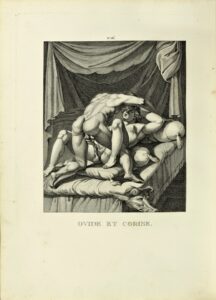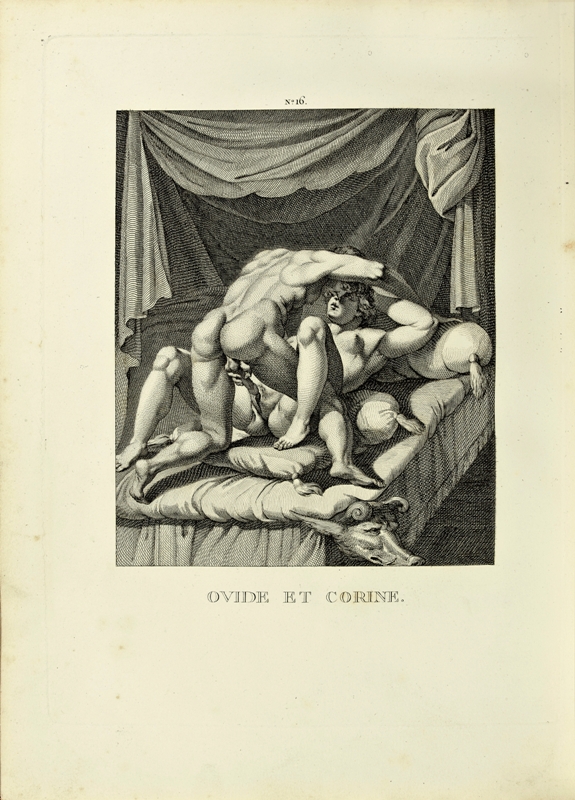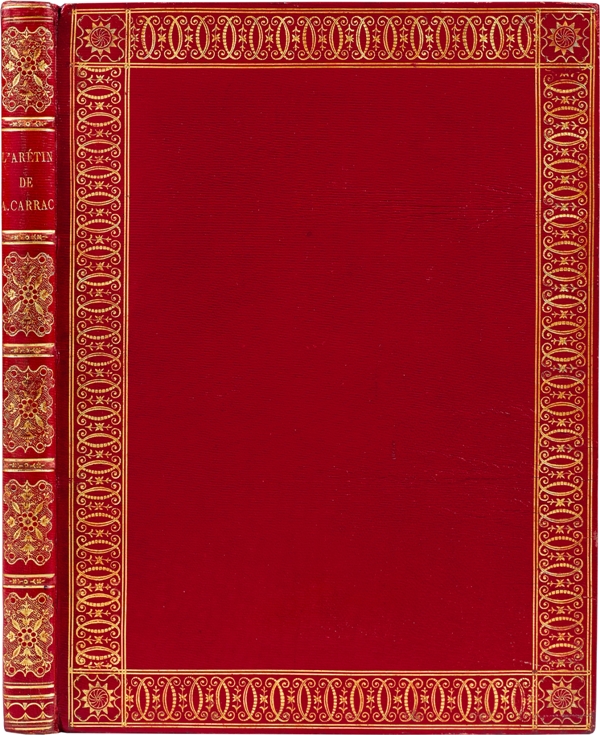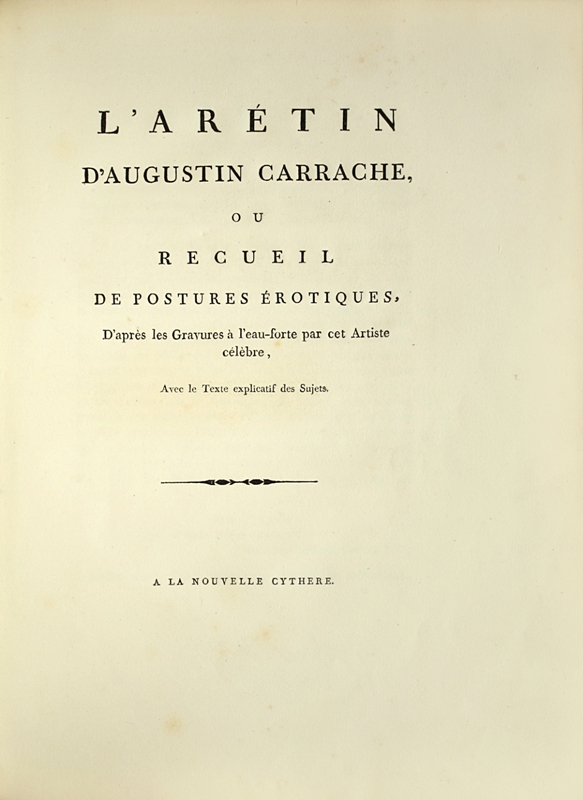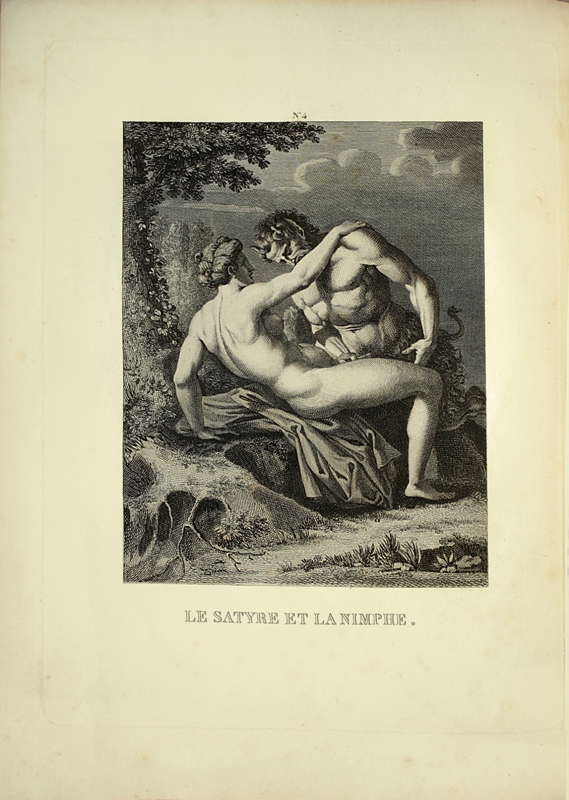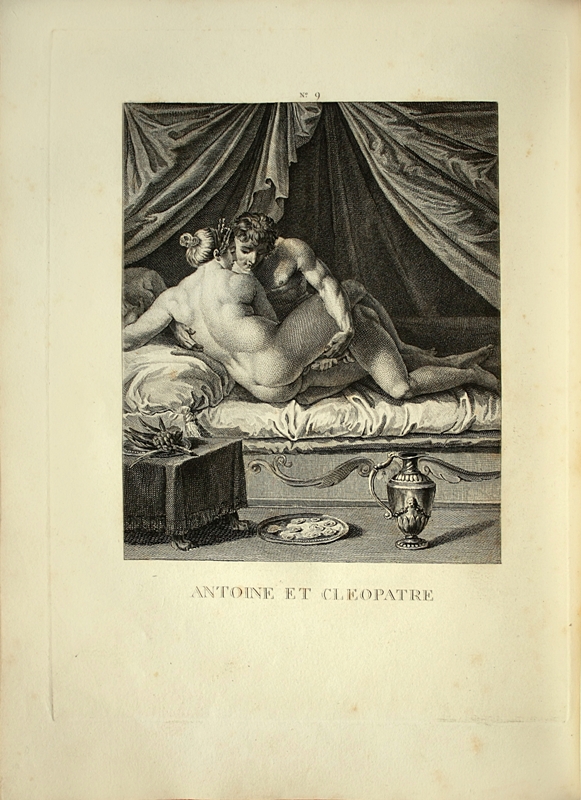A la Nouvelle Cythère [Paris, Didot, 1798].
Large 4to [313 x 235 mm] of (2) ll., 10 pp., (1) l. of table and errata, 80 pp. and 20 full-page numbered engravings out of pagination protected by silk papers. Bound in full straight-grained morocco, large gilt border on the covers, flat spine richly decorated, gilt inner border, gilt edges. Luxury binding attributable to Bozérian.
First and famous edition of Augustin Carrache’s “Aretino”, “the most artistic of erotic books as for the execution of the drawings…” (Cohen, Guide de l’amateur de livres à gravures du XVIIIe siècle. Paris, 1912, col. 88).
Sander, 34 ; Graesse, I, p. 191.
It is illustrated with 20 engravings after Pierre de Jode made after the compositions of Augustin Carrache engraved by Coiny which topic are: « Vénus génitrice, Paris et Oenone, Angélique et Médor, Le Satyre et la Nymphe, Julie et un Athlète, Hercule et Déjanire, Mars et Vénus, Culte de Priape, Antoine et Cléopâtre, Bacchus et Ariane, Polyenos et Chrysis, Le Satyre et sa femme, Jupiter et Junon, Messaline dans la loge de Lisisca, Achille et Briséis, Ovide et Corine, Enée et Didon, Alcibiade et Glycère, Pandore, Le Satyre saillissant. »
“Before speaking to amateurs of the work we are presenting them, we will give a bibliographical note on the two famous men; Aretino and A. Carrache.
Pietro Aretino, illegitimate son of Louis Bacci, gentleman from Arezzo, was born towards 1492. He tried his poetic talent on a sonnet against indulgences. He then attacked the kings and offended them with such a brutal audacity that he was called the princes curse.” “The Aretino was of a great impudence towards the sovereigns […]. It is told that this poet started laughing so much while hearing comic and obscene speeches that he fell from the chair he was sitting on, injured his head and died in the following hour, in Venice, in 1556, at 66 years old.
Augustin Carrache was born in Bologna, in 1560, and became a painter, like his brother.
“A. Carrache’s engravings depicting erotic postures had turned so rare that many people doubted their existence.”
“In 1798, a similar set of engravings were printed, known as ‘L’Aretin d’Augustin Carrache, d’après les Gravures à l’eau-forte par cet Artiste célèbre (The Aretino of Agostino Carracci, after engravings by that famous artist). lt included various sonnets by Aretino and engravings by Jacques Joseph Coiny based on drawings by Agostino Carracci. Though this edition is often thought of as another edition of ‘I Modi’, it bares little resemblance to the original. Though the engravings are very good, there are few similarities between these engravings and the 1550 woodcuts or the Waldeck version of ‘I Modi’.
One difference of note between ‘L’Aretin d’Augstin Carrache’ and ‘I Modi’ is that the engravings in ‘L’Aretin d’Augstin Carrache’ are all based on mythological scenes whereas the ‘I Modi’ engravings make no attempt to tone down the eroticism by hiding behind die historical precedent of depicting nudity through mythology (it’s not pornographic if the participants are Gods).”
A superb and precious volume, which always reached high bids, one of the extremely rare copies preserved in its contemporary straight-grained red morocco decorated binding, coming from Charles Cousin’s collection with ex-libris and an autograph note:
« Charles Cousin (1822-1894) aimait les livres en bibliophile passionné et collectionneur avisé. Cet inspecteur général du Chemin de fer du Nord avait fondé la société des Amis des livres. Il s’était baptisé lui-même Le Toqué, allusion non pas à sa personnalité, mais à ses ‘toquades’ de collectionneur fortuné. »
and Jules Noilly’s with ex-libris, whose auction took place in 1886.
This remarkable artistic erotic work of the 18th century bound in decorated contemporary morocco is a bibliophilic rarity.
